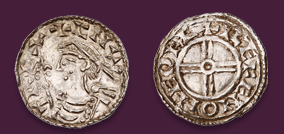
Auction: 11010 - Orders, Decorations, Campaign Medals & Militaria
Lot: 55
x The Unique Three Clasp Combination N.G.S. and French Order of the Lily Pair to Commander C. Royer, Royal Navy, Made Prisoner After a Short, Sharp Action When the Swiftsure was Captured and Taken into Service by the French Navy, 1801 Naval General Service 1793-1840, three clasps, Nile, Egypt, Off Tamatave 20 May 1811 (Charles Royer. Midsn.), ´Y´ in surname corrected, rank contemporarily engraved in large serif capitals; France, Kingdom, Order of the Lily, silver breast Badge, 34mm including crown suspension x 16mm, silver, extremely fine, together with the Certificate of Award for the French award, named to Monsieur Royer, Captaine de Port à Nile, and dated 26.8.1815 (2) Estimate £ 5,000-7,000 Charles Royer served as Able Seaman in H.M.S. Swiftsure 74 guns (Captain Benjamin Hallowell) at the Battle of the Nile, 1.8.1798. A total of one Large Naval Gold Medal (Nelson) and 12 Small Naval Gold Medals were awarded for this action. He served as a Midshipman in the same ship in co-operation with the Army on and off the coast of Egypt, 8.3-2.9.1801. Royer later served as a Lieutenant aboard H.M.S. Astraea 36 guns (Captain Charles Schomberg), and is verified as being aboard in the action with three French frigates, the capture of the Renommée, and the surrender of the Néréide, off Tamatave on the east coast of Madagascar, 20.5.1811 (The Naval General Service Medal Roll 1793-1840 by Captain K.J. Douglas-Morris, R.N. refers) Approximately 87 Off Tamatave 20 May 1811 clasps issued. Commander Charles Royer entered the Royal Navy as an Able Seaman in the spring of 1794, serving in H.M.S. Swiftsure 74 guns, bearing the flag of Rear-Admiral William Parker, in the West Indies. Returning to Britain in December 1795, she was re-fitted at Portsmouth the following year. In October 1797 command passed to Captain Benjamin Hallowell. In early 1798 Royer was serving in Swiftsure when she was ordered to join Rear Admiral Sir Horatio Nelson´s squadron, watching the French fleet at Toulon. After the French escaped and captured Malta in June, and invaded Egypt in July, Nelson and his fleet pursued them, eventually locating them anchored in Aboukir Bay on the 1st August. Ordered at first to reconnoitre Alexandria, the Swiftsure arrived on the scene after dark and moved into the bay to attack. The darkness and the smoke made it difficult to tell which ship was British and which was French, so Hallowell decided to hold fire until he had anchored and prepared his ship. Anchoring across the stern of the French ship Franklin and the bow of Orient, Swiftsure proceeded to open fire on them. After an hour of exchanging shots, a fire was observed in the cabin of the Orient. Concentrating their fire on this area, while H.M.S. Alexander came along the opposite side and did the same, the fire soon spread, and the French began to abandon ship, with a number of the enemy brought aboard the British ships, Swiftsure taking aboard Orient´s first lieutenant and ten men. Shortly after 10:00pm the Orient exploded. After the destruction of the Orient, Swiftsure, in company with H.M.S. Defence, continued to exchange fire with the Franklin, until she surrendered. Swiftsure then moved on to engage the Tonnant, eventually helping to drive her ashore. Swiftsure had seven killed and 22 wounded during the battle; Captain Hallowell received a Small Naval Gold Medal for his role in the battle, and Swiftsure´s first lieutenant, Thomas Cowan, was promoted to commander. On the 8th August Swiftsure took over Aboukir Island, destroying several enemy guns, and carrying the rest away. Two days later, on the 10th August, Swiftsure came across and captured the 16-gun corvette Fortune. Commissioned Midshipman, Royer was still serving in H.M.S. Swiftsure when, in early 1801, she was assigned to the fleet under Lord Keith, covering the landings at Aboukir Bay on the 8th March 1801, where her naval brigade helped to repulse French counter-attacks. Returning to Malta as a convoy escort, Swiftsure was spotted by a French squadron under the command of Rear-Admiral Ganteaume. Already damaged and slow, as well as undermanned, Swiftsure was overtaken by the faster French fleet, consisting of four ships of the line and a frigate. In a desperate engagement of more than an hour´s duration, the French ships Indivisible and Dix-Août succeeded in shooting away her yards and masts, and the Swiftsure was forced to surrender. Two men were killed, two were mortally wounded, and another six were wounded aboard the Swiftsure, whilst the French lost 33 killed and wounded. The captured Swiftsure was taken into service with the French Navy, with her name being retained, and later saw service at the Battle of Trafalgar. After being repatriated, Royer joined as Master´s Mate the brig Camelion (Captain Thomas Staines), and assisted in the boats of that ship at the capture of several armed feluccas near Tarragona. He served subsequently in H.M.S. Kent 74 guns, the flag-ship of Sir Richard Bickerton, and in H.M.S. Victory 100 guns, the flag-ship of Lord Nelson, both in the Mediterranean, where he was promoted Lieutenant, 19th November 1804. In August 1805 he transferred to H.M.S. Ambuscade 32 guns (Captain William d´Urban); the following year he was presented with a gratuity from the Patriotic Fund for injuries sustained whilst aboard. In May 1810 he was appointed to H.M.S. Astraea 42 guns, under the command of Captain Charles Marsh Schomberg. The following year, whilst out cruizing in the Indian Ocean in the company of H.M.S. Phoebe 42 guns, Galatea 42 guns, and Racehorse 18 guns, they encountered, off Tamatave on the east coast of Madagascar the French 40 gun frigates Renommée, Clorinde, and Néréide. Following a long and warmly contested action, during which the Astraea suffered two killed and 16 wounded, the Renommée surrendered. Royer was sent in a boat, accompanied by Lieutenant John Drury, R.M., and five seamen, to take possession of her (Mentioned in Despatches, London Gazette 12.11.1811, where his name is incorrectly given as Charles Roger). Royer left the Astraea in October 1811, and was serving as Harbour Master, Port of the Nile, 1815; he was later advanced to Commander in February 1838, whilst serving as Harbour-Master at Port Louis, Mauritius. Provenance: Glendining, November 1997
Sold for
£6,500




